The National Railroad Museum (NRM) in Green Bay was much more expansive than the cramped quarters at the museum in Duluth. They were also building a new display area for the rolling stock. It would be worth going back in a year or two.
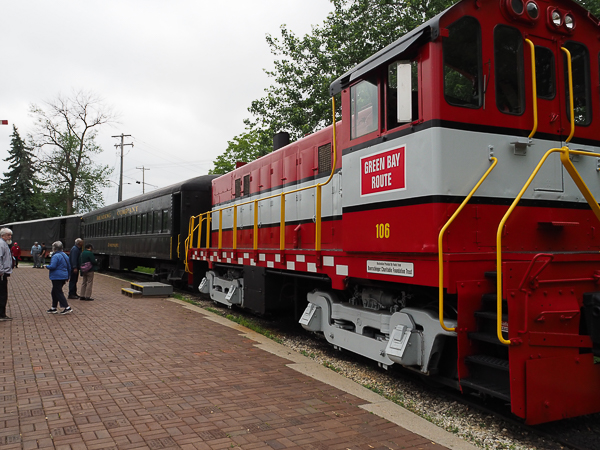
Our visit started with a circuit in their restored railroad.
The locomotive is a switch engine (or switcher locomotive), originally owned by the Southern Pacific. It is an ALCO S-6 now repainted to the museum's specifications.
We rode in the first passenger car, labeled "Josephine." It had a lift that enabled wheelchairs and scooters to load, which made it accessible for some of our number.
From the NRM Facebook page: Built in the 1920s, the "Josephine" car was used by the Reading Company, a Philadelphia railroad. (It's not just a Monopoly property.) This car provided passenger and commercial rail transport in eastern Pennsylvania and neighboring states from 1924 until its acquisition by Conrail in 1976. The car was donated to the NRM and has served as a passenger car for general tours and special events for almost 30 years.
Jim may have ridden on the car when it was still owned by the Reading, but it would not have been called "Josephine" then.
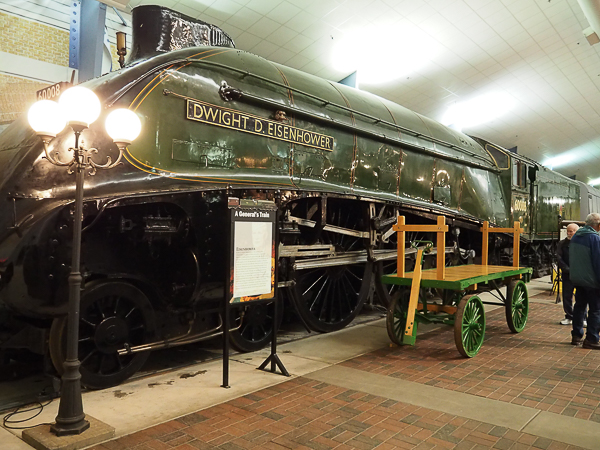
The NRM has the only A4 Class locomotive in the United States. This British locomotive was renamed for General Dwight D. Eisenhower after World War II. Along with the engine are two London and North Eastern Railway cars that were converted for Eisenhower’s use during the war. It's not clear if the locomotive was ever actually used by Eisenhower.
A similar A4 named Mallard holds the world speed record for steam locomotives at 128 MPH. The DDE locomotive was loaned to the UK National Railway Museum in 2012 as part of a celebration of the Mallard's achievement.
Roanoke's own Norfolk & Western 611 could theoretically attain a speed of 140 MPH, but its top speed in service appears to have been 115 MPH. A more typical operational speed was much less than that.
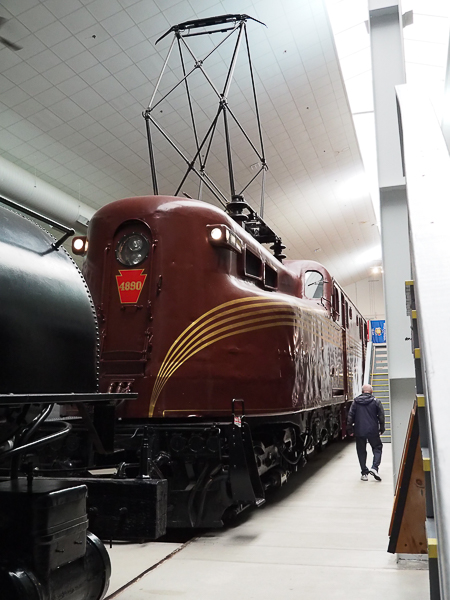
The Pennsylvania Railroad #4890, a GG-1 electric locomotive routinely pulled passenger trains at 100MPH. This one dates from 1940. The locomotive body was styled by Raymond Loewy. There is a gallery dedicated to Loewy in the old Roanoke passenger terminal, which he designed. (Loewy also designed my dream car, the Avanti.)
There was so much rolling stock on display, I have limited myself to pictures related to trains we had ridden (with the exception of the Eisenhower).
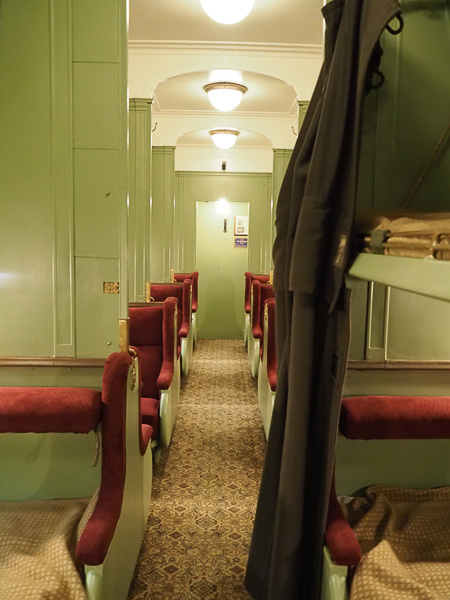
None of the Pullman bedroom cars on display matched my childhood memories, but this car was very like the Pullmans I rode to summer camp in Alabama. The daytime seats made into upper & lower berths for overnight. Curtains provided privacy. The bathroom was at one end of the car, but in those days I didn't have to make regular midnight trips.
There was an extensive display on the challenges and successes of the Pullman Porters. Although the job was among the most prestigious in the black community, it was one of exploitation and abuse. It took many years, but porters were finally able to form an effective labor union under the leadership of A. Philip Randolph, the Brotherhood of Sleeping Car Porters, in 1937. The result was higher pay for fewer hours of work.
Women were also employed aboard Pullman cars, but they were excluded from the union and didn't reap the benefits.
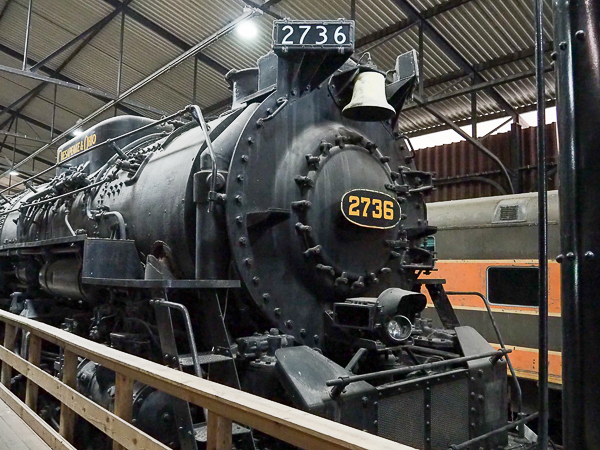
Neither of us ever actually rode on the Chesapeake and Ohio, and we certainly never rode a steam train except on excursions, but I included this picture because it is a "home town" line. Its successor line, CSX, still runs through Rockbridge County. And the Chessie Trail, a very popular local rails to trails conversion, runs between Buena Vista and Lexington.
I was disappointed that there were no Southern Railway representatives.
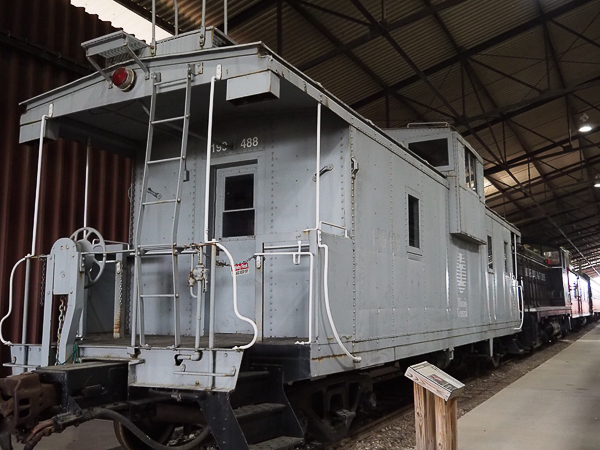
This caboose was the only representative from the Illinois Central. My family spent many hours riding the rails on the Panama Limited and City of New Orleans. A cousin was even an engineer back in the 1930s. He was the secret behind the Panama Limited's unscheduled stop in Magnolia, MS, for my aunt's wedding. Her new Connecticut in-laws were mightily impressed. The family never let on about the cousin.
Some of my favorite childhood memories were of traveling to Chicago every Thanksgiving with my parents in the 1950s on the Panama Limited. We would reserve a bedroom. They shared the downstairs bunk and I got the upper.
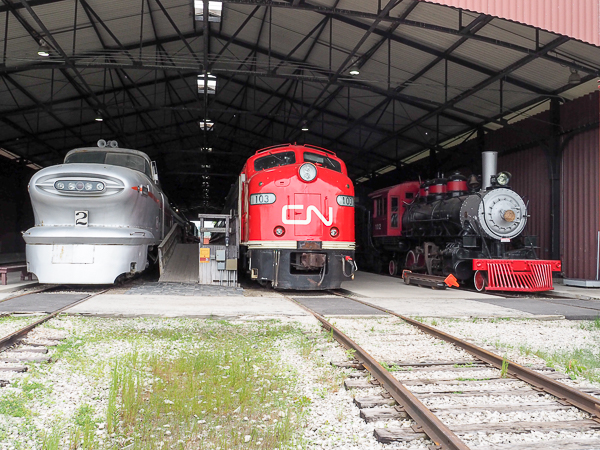
This outdoor display captures three "generations" of locomotives.
The steam engine on the right is from the Sumter and Choctaw RR in Alabama.
The diesel engine was originally owned by the Chicago, Burlington & Quincy as E9A 9986A. It was acquired by CN Rail, painted in CN's heritage livery, and numbered 103. CN Rail loaned it to the National Railway Museum in 2024.
The Aerotrain on the left was designed and built by General Motors using bits and pieces from other projects. It was supposed to be the future of train travel, but failed miserably due to difficult maintenance and rough ride. Only two were built.
After our train excursion, we were back on the ship to proceed to our last stop in Muskegon, Michigan.
Click your "back" button to return to the previous page or click for our picture album.